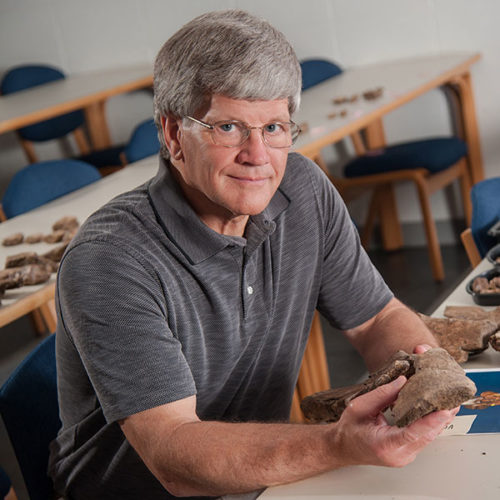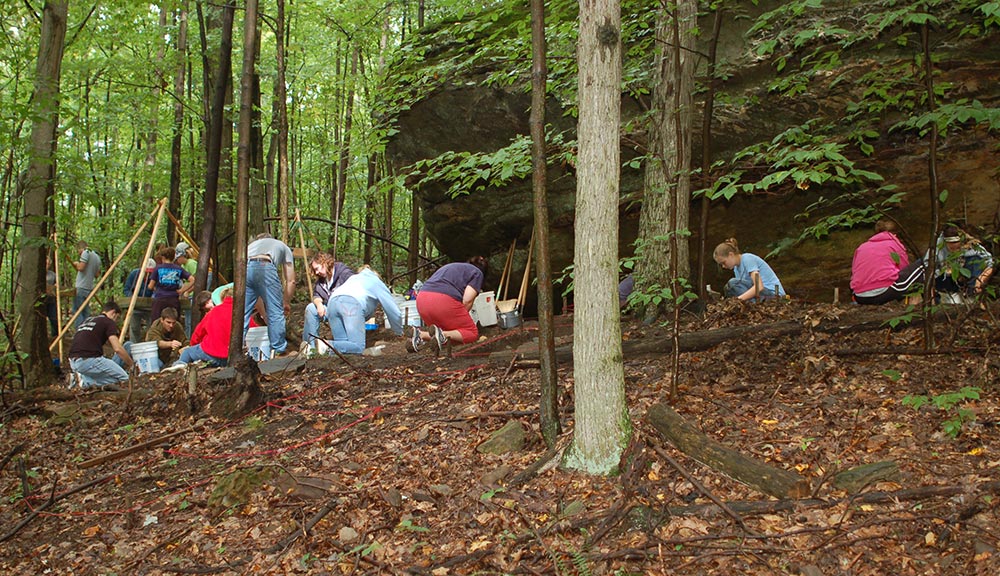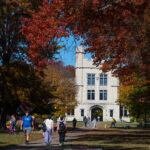
Archaeological excavation uncovers clues that climate change between 1300-1800 disrupted lives of some early Ohio inhabitants

A 30-year archaeological survey and excavation at sites in Ohio’s Walhonding Valley, about an hour south of Wooster, has discovered evidence that the abrupt shift from a warmer to a cooler climate around A.D. 1300 had a very disruptive impact on people living in the area at the time.
Nigel Brush, John Garber Drushal Distinguished Visiting Professor of Archaeology and Anthropology at The College of Wooster, is one of the leaders involved in the archeological research of the area. Brush and his colleagues recovered artifacts from nine Late Prehistoric sites in the Lower Walhonding Valley over the past 30 years. They found some evidence that food storage pits may have been moved to higher terraces to avoid increased flooding during cooler, wetter periods. A partial abandonment of the valley seems to have occurred when people migrated southward during the Phil/Belmont Phase (A.D. 1300-1500). Native cultures suffered a further disruption when migrants leaving northern Europe during the coolest part of the Little Ice Age between A.D. 1300 and 1800, arrived in North America. Additionally, the changing alliances against the British, French, and Americans, plus the declining populations due to disease and warfare, resulted in different tribes merging together, as revealed by the mixed pottery styles found at several of the sites.
“Late Prehistoric Sites in the Lower Walhonding Valley of Coshocton County, Ohio, during a Warm and Cool Period,” an article about the findings, is expected to publish in the fall in the journal Archaeology of Eastern North America. The article summarizes the 30-year-long project at excavation sites in the Walhonding Valley between the village of Warsaw and the town of Coshocton. Students from The College of Wooster and Ashland University were involved as well as members and volunteers of the Ashland/Wooster/Columbus Archaeological and Geologic Consortium. In addition to Brush who is the lead author of the article, Wooster faculty members P. Nick Kardulias, emeritus professor of archaeology and anthropology, and Gregory Wiles, professor of earth sciences, and two members of the consortium were co-authors who made significant contributions to the actual field work or artifact analysis, Brush said.
Brush has had a long association with The College of Wooster, teaching archaeology and geology classes as a visiting professor or adjunct faculty on several previous occasions between 1994 and 2005. He continued to work on various archaeological and geologic projects with Wooster faculty, prior to his current appointment.
He and James Morton started the Walhonding Valley Late Prehistoric Sites Project in 1990 as an offshoot of work they had previously done in the region. As they located more and more sites in the Walhonding Valley from the late Late Woodland to the Late Prehistoric Period (A.D. 700-1700), they believed it might be possible to gain insights into how the people living in the Walhonding Valley at the time had adapted to this significant climate change event that began in A.D. 1300. Brush compared some of the climate changes they may have experienced with today’s climate phenomena.
“The transition period between a warmer to cooler climate, as well as a cooler to warmer climate—such as we are now experiencing—is often accompanied by rapid fluctuations in the weather, such as heavy flooding in some areas, or drought in other places,” he said. For Late Prehistoric people raising corn, beans, and squash in the rich bottomlands of the Muskingum and Walhonding Valley, prolonged floods or droughts could have had devastating consequences and may have resulted in moving fields or storage pits to higher ground if flooding was a problem or moving southward to warmer areas because of the cooler temperatures, he explained.

Wooster students work on site at the Meade Rock Shelter near Glenmont in Holmes County in 2008, alongside Ashland University Students. Photo provided by Professor Brush.
Similar to how recent global warming has impacted plant and animal communities in Ohio including the northward spread of mockingbirds and the appearance of tropical diseases such as West Nile Virus, “one might expect that a climate change event, like the Little Ice Age, that lasted for over half a millennium (A.D. 1250-1850), would also cause significant shifts in animal and plant populations,” Brush said.
“With the limited number of sites we have thus far tested, the relatively small-scale size and duration of our excavations, and the poor preservation of bone and plant materials in Intrusive Mound and Cole Phase sites, we have not yet been able to identify such subsistence changes in the Walhonding Valley,” he said. He believes that such climate-induced changes should eventually show up in future excavations of these Late Prehistoric refuse pits in terms of the types of wood being burned or the type of animals and plants being eaten.
Brush and the consortium, which he founded with Kardulias and Wiles in 2006, is now composed of some 100 professionals, semi-professionals, and amateurs from various counties across Ohio. They will continue their survey and excavation work this fall. Beginning in late August, Brush will lead Wooster students and consortium members in the excavation of a rock shelter between Killbuck and Glenmount in southern Holmes County. In the late fall, once crops have been removed, they will resume work in the Walhonding Valley on a 4,000-year-old flint workshop site that contained thousands of flint flakes and many broken lanceolate points and preforms, as well as participate in a magnetometer survey of Late Prehistoric sites on the west bank of the Mohican River.
Posted in Faculty, News on August 8, 2023.
Related Posts
Related Areas of Study
Earth Sciences
Geology, environmental geoscience, geophysics, and other classes that explore Earth and the impact of humans
MinorArchaeology
Fieldwork and research are a big part of the study of prehistoric and historical archaeology
Major MinorAnthropology
Use problem-solving and research skills to explore and understand communities and cultures in every part of the world.
Major Minor

